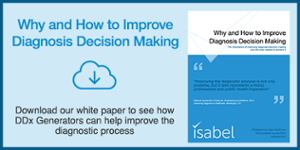- Privacy Policy
- Terms & Conditions
- Contact us
- ©Isabel Healthcare 2020
Using Isabel in a Primary Care Setting, Guest blog - Prof Aneez Esmail
This week’s blogpost comes from a guest author, Professor Aneez Esmail. Aneez is a professor of general practice and a GP himself, and uses Isabel regularly. We asked his thoughts on how he uses Isabel while at work, before our upcoming appearance with him on BBC's The One Show in the UK. Here is what he said.
 Isabel is a fast and effective tool which offers a range of ranked diagnoses in seconds when clinical features are entered, and Isabel comes into its own when used on more complex cases, or when a physician has clinical doubt about their differential diagnosis. Because of this it is considered to be extremely useful in a secondary care setting, but how can Isabel be used effectively in primary care?
Isabel is a fast and effective tool which offers a range of ranked diagnoses in seconds when clinical features are entered, and Isabel comes into its own when used on more complex cases, or when a physician has clinical doubt about their differential diagnosis. Because of this it is considered to be extremely useful in a secondary care setting, but how can Isabel be used effectively in primary care?
Primary Care vs Secondary Care
When a patient has presented to secondary care, he has usually already been screened either in an accident and emergency department or by primary care. Symptoms and hence diagnostic possibilities are usually more serious or complex and a need for Isabel can clearly be seen, but in the primary care setting this can be less obvious. For example, in the UK, a general practitioner might see several children who were presenting with vomiting and fever in one day. The GP will assess the child using a range of clinical information obtained by taking a history, examining the child and then determining further management. It is only when the GP assesses their child as being very ill that they will be referred for further assessment to, for example, the accident and emergency department, and often this decision is reached without tools like Isabel and other similar resources. Once referred, hospital paediatricians make use of Isabel by inputting the same clinical features and history. They are then offered a range of ranked diagnoses, some more serious than others, all of which would now be considered more plausible because the child has been referred to a hospital after initial consultation and the situation is more severe. This is a fundamental challenge of using Isabel in the primary care setting. The epidemiology of illnesses presenting in primary care together with the symptoms are very different from the epidemiology of cases presenting in secondary care with symptoms that are more severe.
Research into Isabel in the Primary Care Setting
My practice, the Robert Derbyshire Practice, connected to the University of Manchester, have been carrying out research that seeks to assess the utility of using Isabel in the primary care setting. We first produced a literature review, which confirmed that as a decision support tool, Isabel was accurate and probably the best tool that was available from the range that we investigated. We then sought to test its use in the primary care setting using the Robert Derbyshire Practice as its testbed, with GPs and other practitioners, including myself, taking part. During the study, participants found Isabel useful and understood its value, however, over a six-month period we found that it was used on only a limited number of occasions. Over the six-month period in a practice of over 18,000 patients, physicians used it as a diagnostic aid in about 30 cases. This could be partly due to the adoption of new tools, and a reluctance to adjust current processes to incorporate a differential diagnosis generator. It was apparent, however, that the vast majority of cases that present in primary care are of patients with self-limiting illnesses or where the physician is confident of the diagnosis and management. It was only more complex cases where symptoms were not clear or where clinical examination does not provide clear evidence of a specific illness that Isabel was considered to be helpful.
Interviews with physicians who took part in the study confirmed general opinion that it was a useful tool to have but it was not needed very often. I described it as a very sophisticated textbook and medical resource, which is useful to have in a clinic for consulting when the physician is not clear as to the likely diagnosis. This may occur where symptoms don't match a particular clinical syndrome, in unusual presentations of symptoms, sometimes in frequent attenders who keep returning with the same symptoms, and sometimes in determining whether referral for further assessment may help in the further management of the clinical problem. Surprisingly, this is not as common as one would imagine and it's not a reflection of the lack of knowledge or clinical skills on the part of the general practitioner, but of the way that people present in primary care and the epidemiology of illness in this setting.
How I use Isabel
I have personally used Isabel for several years, and in my experience it has been on about 7 to 8 occasions in a year. I see about 60 patients a week and most of the time I am confident of the management of the problem. However having Isabel on my desktop enables me to consult an excellent source of information on the occasions when I want to talk to someone about a difficult or perplexing case. I often refer to Isabel as a friend in the consulting room. In such situations Isabel comes into its own. It is fast, accurate and helpful, and in the context of a busy general practice, can save vital time and help clarify any doubts to reach a correct diagnosis.
Have you read our white paper on "Why and How to Improve Diagnosis" yet? Download the white paper below:

Prof. Aneez Esmail
Aneez is Esmail is a Professor of General Practice at the University of Manchester and Director of the National Institute of Health Patient Safety Translational Centre. He continues to practice as a clinician and his research interests include understanding the problems associated with patient safety in primary care.
Subscribe Here!
Recent Posts
Virtual Triage: Do more questions lead to better patient outcomes?
One of the common misconceptions related to virtual triage / symptom checker tools is that the more..Webinar: Using Virtual Triage To Transform Patient Access
Outdated contact centers are posing problems for today's health systems. As longer hold times..List Of Categories
- Differential Diagnosis Decision Support
- Differential diagnosis
- Symptom Checker
- Symptoms
- Medical Error
- Patient Disease Information
- Disease
- Diagnostic Decision Support
- Clinical Decision Support
- Isabel 1 Minute Read
- Diagnosis Error
- Diagnosis Skills Cases
- Healthcare Informatics
- Medical Education
- Patient Engagement
- Clinical Reasoning
- Evidence-based Medicine
- Symptom Triage
- Nurse Practitioner Education
- Nursing Decision Support
- Partnership
- Public Health
- COVID-19
- EHR
- Patient Empowerment
- Patient Safety
- rare disease

Start your FREE Trial today
Try the Isabel Pro DDx generator for 30-days - no payment card details required.




